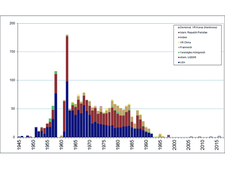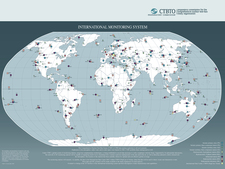-
Topics
subnavigation
Topics
Electromagnetic fields
- What are electromagnetic fields?
- Static and low-frequency fields
- Radiation protection relating to the expansion of the national grid
- High-frequency fields
- Radiation protection in mobile communication
Optical radiation
Ionising radiation
- What is ionising radiation?
- Radioactivity in the environment
- Applications in medicine
- Applications in daily life and in technology
- Effects
- What are the effects of radiation?
- Effects of selected radioactive materials
- Consequences of a radiation accident
- Cancer and leukaemia
- Genetic radiation effects
- Individual radiosensitivity
- Epidemiology of radiation-induced diseases
- Ionising radiation: positive effects?
- Risk estimation and assessment
- Radiation protection
- Nuclear accident management
- Service offers
-
The BfS
subnavigation
The BfS
- About us
- Science and research
- Laws and regulations
- BfS Topics in the Bundestag
- Links
Monitoring the Comprehensive Nuclear-Test-Ban Treaty (CTBT)
- The Comprehensive Nuclear-Test-Ban Treaty CTBT is one of the central international treaties to prevent the proliferation of nuclear weapons.
- The CTBT was opened for signature in 1996. Of the 44 so-called Annex 2 states that have to ratify the treaty before it enters into force, three countries have yet to sign and ratify the treaty and five countries that have already signed, still have to ratify the treaty.
- The CTBTO monitors compliance with the treaty through seismic measurements, radioactivity measurements and special microphones in the oceans and the atmosphere. Several dozens of linked monitoring stations worldwide can detect minute traces of radioactivity in the air.
- The BfS participates in the verification by monitoring radioactivity and operates one of the stations for highly sensitive radioactivity measurements on Mt Schauinsland near Freiburg.
The Comprehensive Nuclear-Test-Ban Treaty is one of the central international treaties for preventing the proliferation of nuclear weapons. Although it has not yet entered into force, a global network to monitor the test ban is being set up now and is operated successfully.
The Comprehensive Nuclear-Test-Ban Treaty

![]() Number of nuclear weapons experiments worldwide until 2016
Number of nuclear weapons experiments worldwide until 2016
With the "Trinity" test on 16 July 1945 in the USA, a nuclear weapon was detonated for the first time in human history. Only one month later, nuclear weapons were detonated in military operations over Hiroshima and Nagasaki at the end of World War II.
Despite early considerations about international control of fissile material for the production of nuclear weapons, other nations acquired the ability to produce these weapons (Soviet Union: 1949, United Kingdom: 1952).
Start of nuclear weapons tests
In the 1950s, the USA and the Soviet Union began testing so-called thermonuclear weapons (colloquially referred to as "hydrogen bombs"), which have a higher explosive yield and correspondingly produce larger amounts of radioactive fallout.
Partial Test Ban Treaty
Among others, the criticism following these tests led to an agreement between the USA, the Soviet Union and the United Kingdom to ban tests in the atmosphere, under water and in outer space in 1963.
This outcome was laid down in an international treaty, the Partial Nuclear Test Ban Treaty (PTBT). France (first test in 1960) and China (first test in 1964), however, did not sign this treaty and conducted nuclear weapons tests in the atmosphere up until 1980.
From the partial to the comprehensive test ban

![]() The International IMS measuring network
Source: CTBTO
The International IMS measuring network
Source: CTBTO
The states signatory to the PTBT complied with the rules of the treaty and consequently reduced the number of atmospheric (above-ground) tests and the associated radioactive fallout. However, the total number of nuclear weapons tests was not reduced, apart from conductiong them mostly below the Earth's surface. More than 2000 nuclear weapons tests have been counted to date.
After the PTBT had entered into force, a comprehensive test ban treaty was discussed at the diplomatic level and in 1976 the so-called "Group of Scientific Experts" (GSE) was established. Their task was to determine whether and how compliance with such a treaty could be verified. A reliable verification system is a crucial prerequisite for states to commit to a ban under international law. Initially, the experts' opinions on the possibilities and limits of scientific verification differed widely.
Comprehensive Nuclear-Test-Ban Treaty
It was the end of the Cold War before formal negotiations began at the United Nations Conference on Disarmament. The consultations in which experts from the BfS had been substantially involved, were completed already two years later and the CTBT opened for signature in 1996.
The parties to the negotiations, however, wanted to ensure that the signatories of the treaty did not enter into binding commitments until all states with nuclear installations - and consequently the capability to produce nuclear weapons - have joined. This is why the document contains a list of 44 states (so-called Annex 2 states) that have to ratify the treaty before it enters into force.
To this day, three out of these 44 states have yet to sign and ratify the treaty for it to enter into force (India, North Korea, Pakistan) and five countries that have already signed, still have to ratify the treaty (Egypt, China, Iran, Israel, USA).
Implementation of the Comprehensive Nuclear-Test-Ban Treaty
Once the Comprehensive Nuclear-Test-Ban Treaty (CTBT) has come into force, the verification of the ban has to be instantly possible. For this reason, the so-called Preparatory Commission for the Comprehensive Nuclear-Test-Ban Treaty (CTBT) with its task to set up an international monitoring network with 337 monitoring stations was established in Vienna. This monitoring network allows to reliably verify compliance with the treaty.
Other tasks of the Comprehensive Nuclear-Test-Ban Treaty Organization (CTBTO) include to preparing concepts for on-site inspections, to develop measurement methods for one-site inspections and to perform exercises.
Monitoring the Comprehensive Nuclear-Test-Ban Treaty
The Comprehensive Nuclear-Test-Ban Treaty Organization (CTBTO) monitors compliance with the treaty through seismic measurements, radioactivity measurements and special microphones in the oceans and the atmosphere.
The Federal Office for Radiation Protection (BfS) participates in the verification by monitoring radioactivity and supports the German Federal Foreign Office in the technical evaluation and assessment of the data.
Monitoring the Comprehensive Nuclear-Test-Ban Treaty
The international network of the CTBTO is designed to detect clanestine nuclear weapons tests worldwide. Several dozens of linked monitoring stations worldwide can detect minute traces of radioactivity in the air. The Federal Office for Radiation Protection operates one of these stations for highly sensitive radioactivity measurements on Mt Schauinsland near Freiburg.
Seismic measurements can give a first indication of an underground nuclear weapons test. The radioactive noble gases resulting from a nuclear weapons test can leak into the atmosphere through the soil with a time lag. If this occurs, these gases can be detected by the highly sensitive radioactivity monitoring stations of the CTBTO and can clearly be attributed to a nuclear weapons test.
Worldwide monitoring system
The CTBTO, with its headquarters in Vienna, is currently setting up a worldwide monitoring system consisting of a network of 321 monitoring stations with the help of the signatory states. The network is able to detect, identify and also locate a nuclear explosion with high probability anywhere on Earth.
This system is based on
- 170 seismometers in the ground,
- 11 hydrophones in the oceans,
- 60 infrasound microphones in the atmosphere and
- 80 radionuclide monitoring stations for radioactivity in the air.
One of these radionuclide monitoring stations is Schauinsland Station of the BfS (Radionuclide Station RN33). The 80 radionuclide stations are supported by 16 radionuclide laboratories for quality assurance.
The importance of radioactivity measurements
The three techniques seismology, infrasound and hydroacoustics can promptly register and locate explosions with yields above 1 kiloton of trinitrotoluene (TNT) equivalent (unit of measurement for the energy released in an explosion). In a next step, the nuclear character of the explosion has to be unambiguously identified by radionuclide monitoring technology.
When an explosive device detonates, a large number of fission products is produced. Most of the radionuclides formed this way do not occur in nature and also differ significantly in composition from the radioactivity released from nuclear power plants.
The area of release can be roughly localised by atmospheric transport modelling.
What is measured?
At the 80 planned radionuclide stations integrated in the operational measuring network, air is sampled for traces of aerosol-bound gamma emitters. 40 of the 80 stations including Schauinsland Station additionally monitor the air for the radioactive isotopes of the noble gas xenon (xenon-131m, xenon-133, xenon-133m and xenon-135).
| Aerosols, for example radioactive iodine | Noble gases (radioactive xenon) | |
|---|---|---|
| Measurement technology | High-purity germanium detector | High-purity germanium detector or beta-/gamma-coincidence |
| Air flow rates | at least 500 cubic metres per hour | at least 0.4 cubic metre per hour |
| Limit of detection | 10 to 30 microbecquerels per cubic metre of air based on barium-140 | 1 millibecquerel per cubic metre of air based on xenon-133 |
Radioactive noble gases were included in the monitoring system as these can be released into the atmosphere by clandestine underground tests and consequently increase the risk of detection for potential treaty violators. It is important to note that by means of measurements distinction can be made between radioactivity from civilian sources and radioactivity from possible nuclear weapons tests, which would constitute a treaty violation.
Analysis of the data
All measurement data are transmitted to the International Data Centre of the CTBTO in Vienna through a satellite-based communications system. There they are analysed, distributed to the signatory states and archived.
State of 2018.07.03


